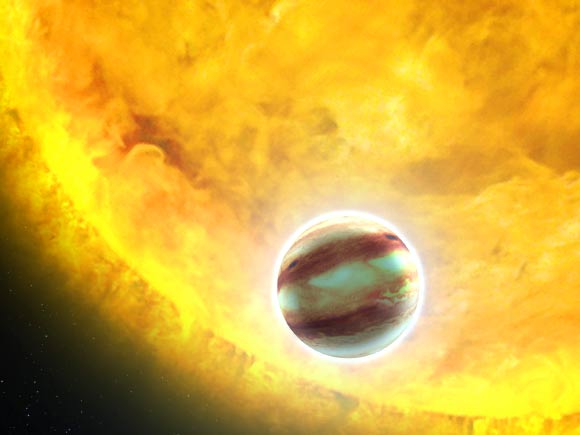New observations of HD 80606b raise questions about origins of so-called hot Jupiters, a class of short-period gas giants with a mass similar to Jupiter’s, says a team of astronomers led by MIT scientist Dr. Julien de Wit.
HD 80606b is a giant extrasolar planet orbiting a star in the constellation of Ursa Major, about 190 light-years away.
This planet is about the size of Jupiter and has a minimum mass of 3.9 Jupiter-masses.
It was discovered in 2001 by Dr. Dominique Naef from the Geneva Observatory and his colleagues from Switzerland, Israel, France, and the United States.
What makes HD 80606b unique is its highly eccentric orbit. Like a comet, this exoplanet spends most of its time far from its parent star, HD 80606, and then, at closest approach, dramatically whips around it.
Every 111.8 days, it shuttles between 79 million miles from its star – equivalent to midway between Venus and Earth in our Solar System – to just 2.8 million miles away. That’s nearly 13 times closer then Mercury’s average distance to the Sun.
At its closest approach, HD 80606b receives a huge amount of energy from its star.
In a paper published this week in the Astrophysical Journal Letters, Dr. de Wit and co-authors report on Spitzer observations of this gas giant over 85 hours, during its closest approach to its star.
The astronomers determined that while the star-facing side of HD 80606b boils up to 2,060 degrees Fahrenheit (1,127 degrees Celsius) during the swingby, these roasting temperatures are short-lived.
Surprisingly, they found that the planet cools in fewer than 10 hours as it orbits away, reaching temperatures so cold that it becomes invisible to Spitzer for the rest of its orbit.
Astronomers think that hot Jupiters start out in circular orbits similar to Jupiter’s, far away from their stars. At some point, something large and massive like a nearby star pushes them into eccentric orbits.
These exoplanets are then squeezed by their host stars’ gravity every time they whip close by.
During every close encounter, a fraction of the gravitational energy used to squeeze the planets is dissipated as heat, slowly reducing the eccentricity of the planets’ orbits, which eventually end up tight and circular – a process known as circularization.
How long the circularization phase lasts depends on how ‘squishy’ or pliable the planet is, given its interior properties.
However, the new observations of HD 80606b suggest that the exoplanet is not as squishy as expected.
Therefore, the planet is not migrating as fast as previously thought and may maintain its highly eccentric orbit for another 10 billion years or more.
“If this is the case, scientists may have to rethink theories on how hot Jupiters are formed, as it implies that the underlying migration mechanism may not be as efficient as once believed,” Dr. de Wit said.
“Alternative theories for how hot Jupiters form — in which gas giants develop close to their stars or smoothly spiral inward with the help of planet-forming disks — may be more likely explanations for hot Jupiter evolution.”
He and his colleagues also calculated the rotation rate of HD 80606b – the first exoplanet rotation rate ever obtained.
“Its rotation rate, essentially the length of its day, is estimated to be 90 hours, which is twice as long as predicted for this planet,” the astronomers said.
_____
Julien de Wit et al. 2016. Direct Measure of Radiative and Dynamical Properties of an Exoplanet Atmosphere. ApJ 820, L33; doi: 10.3847/2041-8205/820/2/L33








